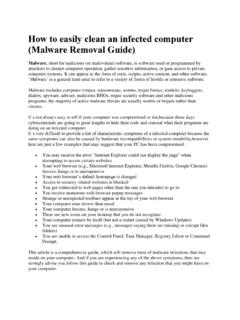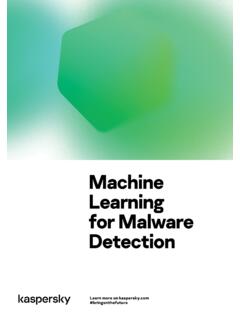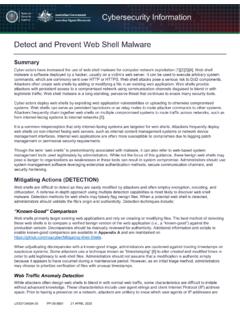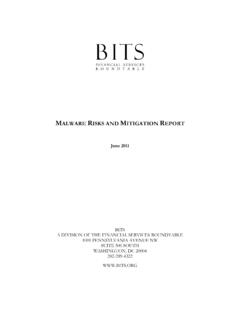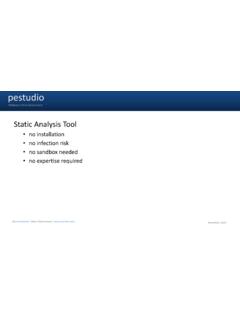Transcription of PRESENTS 2020 State of Malware Report
1 2020 State of Malware ReportFebruary 2020 PRESENTST able of contentsExecutive summary ..4 Methodology ..5 Key takeaways ..6 Windows threat landscape 2019 ..8 Consumer threat categories ..8 Business threat categories ..10 Consumer threat families ..12 Business threat families ..13 Family deep dive ..15 Windows threats summary ..23 Mac threat landscape 2019 ..24 Top Mac threats ..25 Family deep dive: Mac edition ..26iOS ..29 Mac threat summary ..30 Android threat landscape 2019 ..31 Pre-installed Malware ..31 HiddenAds ..32 Monitor category: stalkerware ..32 Android threat summary ..332020 State of Malware Report2 Table of contentsWeb threat landscape 2019 ..33 Compromised infrastructure ..33 Web kits ..35 Malvertising and redirection campaigns ..36 Web threats summary ..37 Regional threats 2019 ..38 NORAM threat landscape ..38 EMEA threat landscape ..39 APAC threat landscape ..41 LATAM threat landscape.
2 45 Top industry threats ..46 Services ..48 Education ..49 Retail ..49 Data privacy in 2019 ..50 Data privacy in commerce ..51 Data privacy in US law ..52 Data privacy summary ..532020 cybersecurity predictions ..54 Conclusion ..57 Contributors ..572020 State of Malware Report3It was the last year of the 2010s, and cybercriminals let the world know they meant business. From an increase in enterprise-focused threats to diversification of sophisticated hacking, evasion, and stealth techniques to aggressive adware aimed at Androids, the 2019 threat landscape was shaped by a cybercrime industry that was all grown up. While Malwarebytes observed a relative plateau in the overall volume of threat detections in 2019, our telemetry showed a clear trend toward industrialization. Global Windows Malware detections on business endpoints increased by 13 percent, and a bifurcation of attack techniques split threat categories neatly between those targeting consumers and those affecting organizations networks.
3 The Trojan-turned-botnets Emotet and TrickBot made a return in 2019 to terrorize organizations alongside new ransomware families, such as Ryuk, Sodinokibi, and Phobos. In addition, a flood of hack tools and registry key disablers made a splashy debut in our top detections, a reflection of the greater sophistication used by today s business-focused attackers. Meanwhile, the 2019 mobile threat landscape fared no better. While Malwarebytes launched a massive drive to combat stalkerware apps that enable users to monitor their partners every digital move which led to an increase in our detections, other nefarious threats lingered on the horizon, with increases in their detections not being helped along by our own research efforts. We observed a rise in pre-installed Malware and adware on the devices of our Android customers, with the goal to either steal data or steal fact, adware reigned supreme for consumers and businesses on Windows, Mac, and Android devices, pulling ever more aggressive techniques for serving Executive summaryGlobal Windows Malware detections increased by 13% on business endpointsRise in pre-installed Malware and adware on Android devicesFor the first time ever, Macs outpaced Windows PCs in number of threats detected per endpoint2020 State of Malware Report4up advertisements, hijacking browsers, redirecting web traffic, and proving stubbornly difficult to uninstall.
4 And for the first time ever, Macs outpaced Windows PCs in number of threats detected per endpoint. Even exploits, malvertising, and web skimmers had a banner year. Outside of cryptominers and leftover WannaCry infections, it seemed there were few cybercrime tactics being outright abandoned or on the an increase in impact and reach, then, came an increase in public awareness and scrutiny. And in no area was this more apparent than data privacy. On the heels of the Global Data Privacy Regulation (GDPR) in Europe and several public social media failures, a tsunami of data privacy legislation, proposals, fines, controversies, and public policies came forward in 2019. After a decade marked by seemingly hundreds of high-profile data breaches, the fallout from all that personally identifiable information (PII) floating around on the dark web finally State of Malware Report features data sets collected from product telemetry, honey pots, intelligence, and other research conducted by Malwarebytes threat analysts and reporters from January 1 through December 31, 2019.
5 Data from the previous year is used to demonstrate year-over-year change. Our telemetry is derived from Malwarebytes customers, both consumer and business, limited to only real-time detections from active, professional, and premium accounts. This selection reduces outlier data that may skew trends. For example, a user installing Malwarebytes for the first time may have hundreds or thousands of detections from existing infections that weren t actively spread during the timeframe of our study. These detections could then muddy data on the distribution or prominence of a particular threat. In addition, we focus on named threats rather than generic detections gathered by heuristics ( anomalous behavior detections), as they provide little-to-no intelligence value. To that end, the numbers presented in this Report represent a percentage of our total collected telemetry, however, this percentage tells the most accurate story about the global threat landscape in State of Malware Report5 Key takeaways There s been an increasing move over the last two years to organizations over consumers.
6 Overall consumer threat detections are down by 2 percent from 2018, but business detections increased by 13 percent in 2019. This resulted in a mere 1 percent increase in threat volume year-over-year. The sophistication of threat capabilities in 2019 increased, with many using exploits, credential-stealing tools, and multi-stage attacks involving mass infections of a target. While seven of 10 top consumer threat categories decreased in volume, HackTools a threat category for tools used to hack into systems and computers increased against consumers by 42 percent year-over-year, bolstered by families such as MimiKatz, which also targeted businesses. Organizations were once again hammered with Emotet and TrickBot in 2019, two Trojan families that started out as simple bankers/info-stealers then evolved into downloaders and botnets. This was reflected in global business detections, as well as regional and vertical-focused telemetry, where TrickBot and Emotet surfaced in the top five threats for nearly every region of the globe, and in top threat detections for the services, retail, and education industries.
7 Emotet was Malwarebytes overall second most-detected threat against organizations, increasing by 6 percent over 2018. However, TrickBot s growth in 2019 has been much greater than Emotet s. At fourth place in our top business detections, TrickBot rose by 52 percent from last year. Ransomware detections have slightly declined from 2018, however, this is due to a lower rate of WannaCry detections leftover from 2017. Net new ransomware activity against organizations remains higher than we ve ever seen before, with families such as Ryuk, Phobos, and Sodinokibi making waves against cities, schools, and hospitals. In fact, Ryuk detections increased by 543 percent over Q4 2018, and since its introduction in May 2019, detections of Sodinokibi have increased by 820 percent. Adware has become much more aggressive in 2019, heavily targeting consumer and business endpoints on Windows, Mac, and Android devices.
8 A new team of the most active adware families have replaced the top adware family detections of 2018. In total, we saw approximately 24 million Windows adware detections and 30 million Mac detections. The top three consumer threat detections belonged to adware families and the number one business detection was also adware. The number one Mac detection, an adware family called NewTab, brought in 28 million detections itself. We saw a significant rise in the overall prevalence of Mac threats in 2019, with an increase of over 400 percent from 2018. However, part of that increase can be attributed to an increase in our Malwarebytes for Mac userbase. To see if that increase reflects the reality of the Mac threat landscape, we examined threats per endpoint on both Macs and Windows PCs. In 2019, we detected an average of 11 threats per Mac endpoint nearly double the average of threats per endpoint on Windows.
9 Of the four global regions, North America (NORAM) was responsible for 48 percent of our detections, with Europe, the Middle East, and Africa (EMEA) in second place at 26 percent. Latin America (LATAM) and Asia Pacific (APAC) brought up the rear, with 14 and 12 2020 State of Malware Report6percent, respectively. Two regions saw decreases in overall threats: EMEA detections dropped by 2 percent and APAC, outside of Australia, New Zealand, and Singapore, decreased by 11 percent. In Australia and New Zealand, the dip was more prominent at 14 percent. North America was at the receiving end of more than 24 million threats, up 10 percent from 2018. But LATAM saw the most growth in 2019, up to million detections, an increase of 26 percent. On the web threats front, a shift by browser developers to rely more on the Chromium platform gave us concern for the discovery and development of new exploits against today and tomorrow s browser applications, and not just for the aging and dwindling Internet Explorer.
10 Meanwhile, web skimmer activity was at an all-time high in 2019, with groups like MageCart aggressively modifying payment processor sites to steal financial information without the need for Malware to be installed on the endpoint. Finally, data privacy was heavy on the public mind in 2019, post-GDPR. Several new pieces of legislation were passed in the United States, including laws in Maine, Nevada, and California that may serve as the backbone for future federal regulation. In addition, tech companies such as Apple, Malwarebytes, ProtonMail, and Mozilla launched privacy-forward products in 2019, including tracking blockers, tracking-free browsers, and encrypted calendar tools. On the flip side, many privacy blunders were made by tech juggernauts, such as Google, Amazon, and Facebook, who shipped products with secret microphone features and vulnerabilities enabling customer data to be viewed by employees, sold user data to third-party companies without express permission, and committed other manhandlings of user PII.


